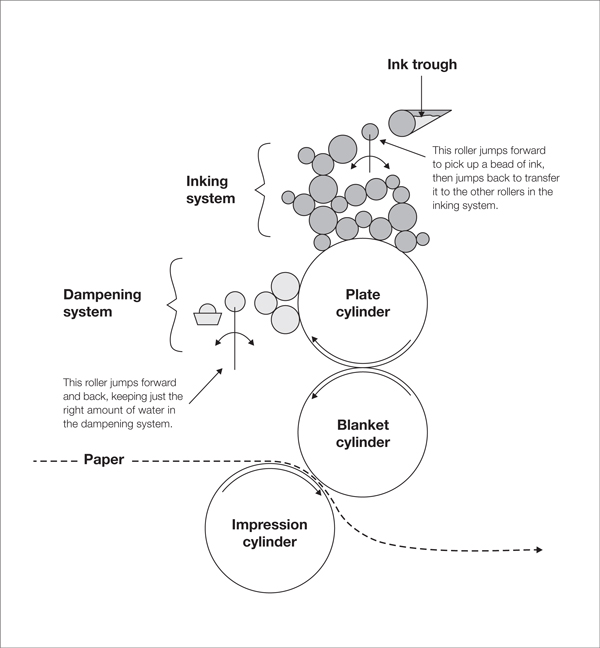The Offset Litho Process
On a good day, offset litho printing works as follows. Paper is loaded onto a platform at the back end of the press, above which is a series of suckers. These lift the paper, one sheet at a time, and enable the grippers (grabbing pincers mounted on a chain-link drive) to grab it along one edge (called the gripper edge) and pull it into the first ink unit, where it is printed with the first color. As it leaves, it is grabbed again and pulled forward into the next ink unit, and so on.
Presses vary as to how many ink units they have. Book presses typically have just one ink unit in order to print only black text, and are often very large format to allow many pages to be printed together on a big “parent” sheet.
Presses used for color work usually have at least two and preferably four units (for cyan, magenta, yellow, and black, the CMYK colors). They may have a fifth and even a sixth unit for a varnish and/or a spot color (i.e. a non-CMYK ink, also called a special color), which is usually a custom Pantone color mix (see Chapter 10). While four-color printing can be achieved one color at a time using a press with a single ink unit, this is far less efficient and more prone to registration problems.
The way an ink unit works is shown in fig. 1.10. At the top, there is a trough containing ink. Sitting in the trough is a roller that turns slightly every few seconds. Behind this roller is another roller that jumps forward to touch it, picking up a long bead of ink, then jumps backward to spin against the other rollers in what is called the inking system. This system is a complex series of rollers designed to bring the ink down onto the plate in a controlled way. Usually only three or four rollers out of the whole array actually touch the plate surface and transfer the ink onto it.
Behind the plate cylinder is another vital set of rollers comprising the dampening system. This is a smaller and simpler unit that uses a similar method to cover the background areas of the plate lightly with a pH-balanced solution, mostly water.
Many people assume that the image is transferred onto the paper by the plate. Not so. The plate is a thin sheet of aluminum (sometimes zinc or another material) and has a hard surface. It would quickly wear out if it had to come into contact with a comparatively abrasive material like paper for very long. Instead, the image is transferred (“offset”) onto the blanket cylinder, a roller covered with a canvas-backed sheet of rubber. Hence the term “offset printing.”
The blanket, being rubber, can press down hard on the paper with no problem. Simultaneously, the impression cylinder presses from underneath. The resulting pressure stops the paper slipping as it moves between the two, creating a sharp image.
After the last unit on the press, the paper hits a stop bar just as the grippers let go of it, and settles onto an ever-increasing pile on another trolley. Typically, sheet-fed presses are run at around 3,000 sheets an hour.
Paper is very heavy. It is made mostly from wood pulp, and a stack of it sitting on a pressroom trolley can easily weigh a few hundred pounds or more. After the first run through the press, the side facing down is nice clean paper, but the other side, facing up, is fresh, wet ink. So why is it that the clean side of a sheet does not stick to the wet side of the sheet underneath it? (That is also a kind of “offset,” by the way, but in this instance it is called set-off.) The answer is quite simple: cornstarch. Printers call it “offset spray” (perhaps “cornstarch” would not sound “printerly” enough), but it is the same stuff. The idea is that, just as the grippers let go and the sheet starts to fall gently onto the stack, an air blower puffs out a little cloud of offset spray beneath it—just enough to ensure a few particles, and therefore a very small space, is left between each sheet. Offset spray used in this way is too fine to see, but when a stack is dry you can sometimes feel it as a slight roughness on the paper surface.
Since offset spray tends to build up around the end of the press, the printer will occasionally use compressed air to blast it all away—thus creating a whole bunch of potential disasters as accumulated clumps fall from the ceiling and land in the ink system.
1.10 How a single ink unit works on an offset press.

